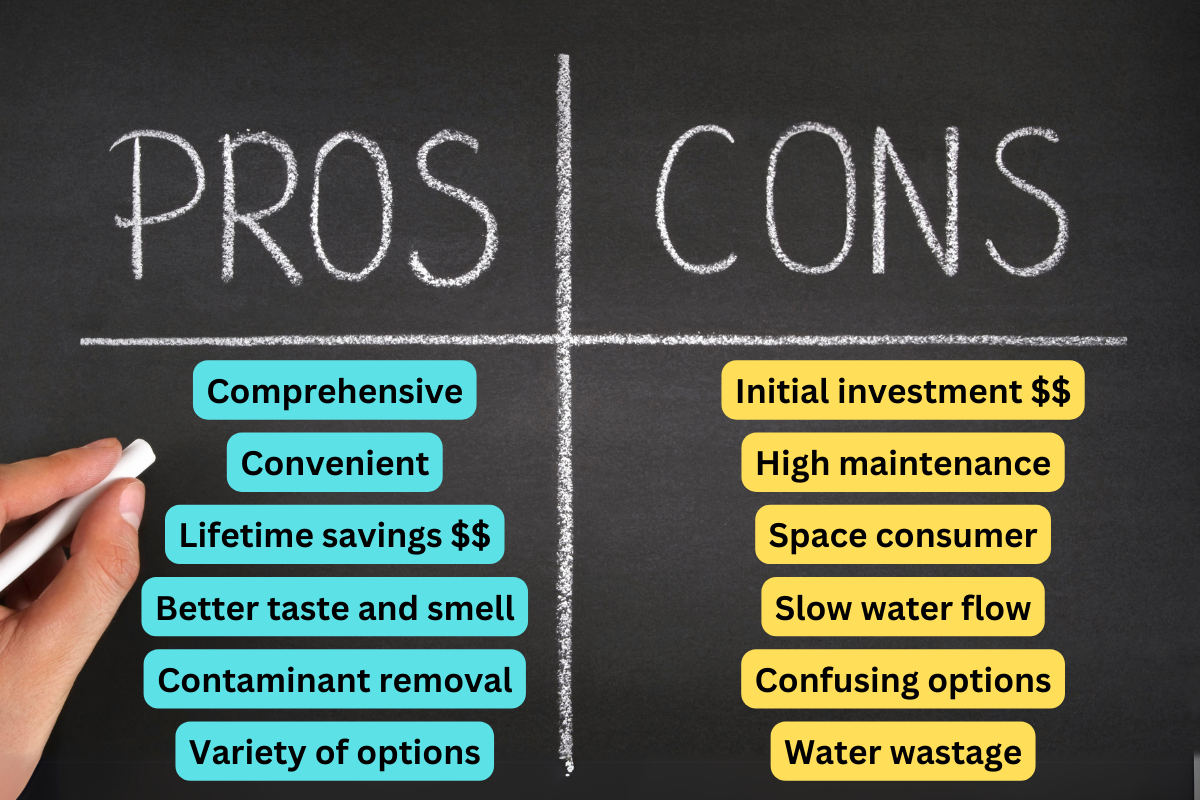Whole house water filters are extensive filtration systems that treat water at the point that it enters your home. This guarantees a continuous supply of filtered water to all faucets and appliances in your home.
A whole-house water filter is easy and convenient to use, improves water quality throughout your home, comes in a variety of options, saves costs, and has benefits for your health. On the flip side, it has some cons like the need for regular maintenance, high installation cost and water wastage plus space requirements.
With the rising concerns about water contaminants, many of us are turning to whole house water filters as a solution. These systems promise a comprehensive approach to water purification, but like any technology, they come with their own set of advantages and disadvantages. This article explores the pros and cons of whole house water filters (so that you don’t have to) to help you make an informed decision about whether they’re the right choice for your home.
Pros of Whole House Water Filters
It’s important to understand that a whole house water filter is a filtration system that treats water at the point it enters your home (not at the tap). This means that every water source in your house, from your kitchen tap to your shower, benefits from filtration.

Comprehensive Water Purification
One of the biggest advantages is that these filters provide clean water throughout the house. Whether it’s for cooking, drinking, washing, or bathing, you’re assured that the water is filtered.
As water flows into your home from the main water line, a whole-house water filter removes contaminants and improves your water quality. Every plumbing fixture in your home, including kitchen faucets, bathroom showers, and every appliance that uses water, will constantly be supplied with properly filtered water.
Removal of Contaminants
These systems are effective in removing a variety of contaminants like chlorine, heavy metals, and organic compounds, significantly improving water quality. This is probably the most obvious positive of using a whole house water filter. Depending on the type of system you invest in, you can remove almost all contaminants – reverse osmosis options are the most efficient.
Convenience
With a whole house system, you don’t need multiple filters for different areas. This single system takes care of all your water purification needs.
Once your whole-house filter has been installed, you don’t have to worry about anything other than scheduled maintenance.
You don’t have to constantly re-fill the filter like you would for point-of-use filters, like water filter pitchers. You also don’t have to worry about the filter taking up space on or underneath your cabinet like water coolers or under-sink filters.
A whole-house filter improves the quality of your water throughout your house. Knowing that every faucet you turn on will produce good-quality water gives you peace of mind. With other types of filters, you have to go to a specific faucet or location in your house just to get filtered water, which is not as convenient.
Improved Taste and Smell
By removing contaminants, these filters also improve the taste and smell of your water, which is particularly noticeable with drinking and cooking water. Water can taste soapy, metallic or earthy depending on the chemicals in your water. A whole house water filter can remove each of these and improve the taste (and smell) of your water.
Health Benefits
Filtered water can be better for your skin and hair, especially in areas with hard water. It also reduces the risk of consuming harmful contaminants.
The water you drink has a lot of impact on your health. Contaminants in water can make you feel sick and reduce your overall immunity. Whole-house water filters remove these contaminants from your water, reducing the effect they can have on your health and of everyone else in your house.
Whole house filters improve the quality of water you drink and cook with. They also improve the quality of your bathing water. These filters remove harsh chemicals like chlorine and chloramines that our water providers use to treat the water. These chemicals can dry out your skin and hair and may irritate your skin. With whole-house filters, these harsh chemicals are removed from your water.
Long-Term Savings
Although the initial investment might be high, in the long run, whole house filters can be cost-effective compared to buying bottled water or replacing individual filters.
Consider the cost of buying bottled water for daily consumption – for a family of four, this could easily amount to several hundred dollars a year. For example, a household spending $25 a week on bottled water could save over $1,300 annually by switching to filtered tap water.
When compared to other types of water filtration systems, whole house filters often prove to be more economical in the long run too. Point-of-use systems, like faucet filters or pitcher filters, need frequent cartridge changes and only serve one tap. In contrast, a whole house system, with its larger capacity, requires fewer changes and covers all water outlets in the home.
This centralized approach not only reduces the cost of consumables but also offers efficiency in maintenance. For example, replacing a single filter in a whole house system might be equivalent in cost to replacing multiple point-of-use filters, but needs to be done less often. The improved water quality also extends the life of plumbing and appliances by reducing scale and sediment buildup, translating to less frequent repairs and replacements compared to homes using unfiltered water.
When water contains impurities like iron, calcium, and magnesium, your appliances are prone to rust, stains, and blockage. These impurities can deposit on your clothes and dishes, staining them. They can even diminish the texture, color, and lifespan of your clothes. So a whole house water filter can save you money in all sorts of ways.
Variety of options
Whole-house filters are very versatile options for water quality improvement. These filters come in different forms, allowing you to pick one that is best suited to your preference or the specific water concern you have.
These filters offer a comprehensive water quality solution at the point of entry. Whether sediment removal, taste and odor improvement, disinfection, or removal of certain chemicals. Your whole-house filters can be a reverse osmosis system, activated carbon filter, UV light enabled, water softener, or a combination of different filtration methods. With whole-house filters, you get to tailor your water quality to your taste and enjoy the benefits throughout your entire house.
Cons of Whole House Water Filters
While whole-house filters are great and offer several benefits, they aren’t perfect (what product is?). Here are some cons of using a whole-house filter.
Initial Investment
The upfront cost of installing a whole house water filter can be quite high. This includes not just the system itself, but also installation costs. For the system and its installation, you’ll need to budget between $300-$10,000, depending on the brand and type of filtration system. Installation is not a DIY project and requires professional help.
This initial expense will likely eventually be offset over time by reduced spending on bottled water, maintenance of appliances, and other costs incurred by the effects of poor-quality water. Despite this, the cost can be discouraging or even unaffordable for some.
Maintenance Requirements
One disadvantage of a whole-house water filter is that the components of whole-house water filters may not last very long. While the whole house filtration system itself can last years – about 10 to 20 years on average with proper care – it needs regular maintenance.
The regular whole-house filtration system takes your water through different stages of filtration. These stages use sediment filters, carbon filters, etc. The filters need to be replaced at regular intervals, depending on the specific filter type and the brand of your whole-house filtration system. The sediment filter, for instance, may need to be replaced every six months, and your micron filter every 9 to 12 months.
Resin beds, UV bulbs, and RO membranes will also need replacement depending on your type of filter. How frequently you need to replace components largely depends on the volume of use and the quality of water it filters. Typically, you may need to replace some components within a year to keep your filtration system functioning optimally.
Although this routine maintenance keeps the system operating at peak efficiency, it increases the overall cost and time commitment to system maintenance.
Space Consumer
Whole-house filters can take up a significant amount of space. If you don’t have a lot of space in your home or live in a rented place with limitations, a whole-house filtration system may be difficult to choose and install.
Slow Water Flow
Some systems may reduce water pressure or flow rate in your home, which can be inconvenient.
Not All Filters are Equal
There is a large variety of Whole house water filters available, each one is designed to target specific contaminants. This can make choosing a system for your specific water contaminants confusing… here is a breakdown to make it easier for you:
- Sediment Filters: Ideal for homes with visible particles in their water. They remove larger particles like sand, dirt, and rust.
- Activated Carbon Filters: Commonly used for removing chlorine, pesticides, and organic compounds. They improve taste and odor but are less effective against heavy metals and minerals.
- Reverse Osmosis (RO) Systems: These are more comprehensive and can remove a broad range of contaminants, including heavy metals, fluoride, and bacteria. However, they are typically more expensive and require more maintenance. While RO systems are often used for point-of-use, they can be scaled up for whole house use.
- Ion Exchange Filters: Effective in softening water by removing minerals like calcium and magnesium, these filters are ideal for homes with hard water.
- Ultraviolet Filters: These use UV light to kill bacteria and viruses, suitable for homes concerned about microbiological contamination.
Each type of filter has its strengths and weaknesses, and a combination of these technologies can be used to create a tailored solution for your home’s specific water quality issues. For instance, a house with both hard water and high chlorine levels would benefit from a system combining ion exchange and activated carbon filtration
Wasted Water
Some whole house water filters, particularly those with a backwash cycle, can waste water. Some whole house water filters, especially those that operate on a backwash principle, can lead to water wastage.
This is particularly true for reverse osmosis systems, which can waste several gallons of water for every gallon of filtered water produced. For example, an RO system with a 4:1 waste ratio will waste 4 gallons of water for every gallon of purified water. This not only impacts your water bill but also raises environmental concerns, especially in areas where water conservation is critical. Considering this factor is essential in regions facing water scarcity or for homeowners aiming for sustainable living.
Read more about which reverse osmosis systems waste less water here.
